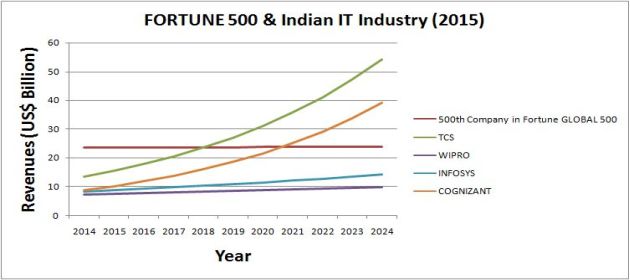In the latest GLOBAL 500 list published by FORTUNE magazine in August 2015, WAL-MART STORES (USA) ranks #1 and WUHAN IRON & STEEL (China) ranks #500.
EDIT: The above table has been revised to reflect the correct profit of Wuhan Iron & Steel, which is US$ 54.5 million, not billion.
The world’s 500 largest companies collectively generated US$ 31.2 trillion in revenues and US$ 1.7 trillion in profits in the latest fiscal year (ended on or before 31 March 2015).
(In the nearly two decades that I’ve been following the FORTUNE GLOBAL 500, this is the first time that it’s not featured as the cover story. Appearing as a thin strip on the issue’s cover is just one of the many changes I’m seeing in FORTUNE magazine in recent times but that’s a topic for another blog post.)
On page 93 of this issue, I noticed a graph (shown on the right) predicting that China’s TenCent will join the GLOBAL 500 in 2018. When I examined it carefully, I noticed that the line representing the projected revenue of the last company on the list was flat.
I was a bit taken aback by this because, when I’d done a similar forecast for the Indian IT industry three years ago, the same line – based on the prevailing growth rate at the time – was clearly trending upwards.
I was wondering if FORTUNE had made some goof up – one of the many I’ve been sadly noticing in the recent past – and went back to check the revenue tables. Well, there was no goof up. The revenue of the company ranked 500 on the GLOBAL 500 has actually flatlined at ~US$ 23B in each of the last three years.
Well, I hadn’t reckoned with a flat entry barrier when I’d made the following predictions in Has The Indian IT Industry Missed The FORTUNE 500 Bus?:
- TCS will not enter the GLOBAL 500 until 2021
- COGNIZANT will become a GLOBAL 500 corporation in 2020.
I was curious to know if this new development had any impact on year of entry of an Indian IT company into the GLOBAL 500.
I checked the latest results of these two companies and found out that neither had managed to maintain its earlier growth rates. The slowdown was relatively minor in the case of TCS (14.97% versus 18.1%) but quite substantial in the case of COGNIZANT (16.05% versus 33.3%).
At first glance it appeared that since the growth of the 500th company in GLOBAL 500 and of TCS and COGNIZANT had all cooled down at the same time, my above predictions should continue to hold good.
But I was not content to leaving this to gut-feeling and decided to rework my earlier model based on the latest figures. When I did that, the following picture emerged:
(Click here to download the model in Excel format).
Based on this,
- TCS will join the GLOBAL 500 in 2019 (or even 2018, which list it misses only by a whisker). The earlier-than-predicted entry of India’s largest IT company is driven by a comparatively lower drop in its growth rate compared to the lowest ranked company on the list.
- COGNIZANT’s entry into the GLOBAL 500 will get pushed out to 2021, thanks to a bigger fall in its sales growth even compared to the last company on the list.
The above predictions assume that both companies maintain their latest revenue growth into the future. Going by the experience of the last two years, that’s not a cinch as it used to be in the bygone years.
That said, because organic growth has cooled, these companies are perhaps now more likely than in the past to use their huge cash reserves to engage in some big-ticket M&A activity. In that case, they could grow faster than in the latest fiscal year and enter the GLOBAL 500 earlier than predicted.
With COGNIZANT having totally shed its Indian origins, it’s now down to a truly Indian IT company – TCS – to win a place for the Indian IT industry in the Fortune GLOBAL 500 list.




